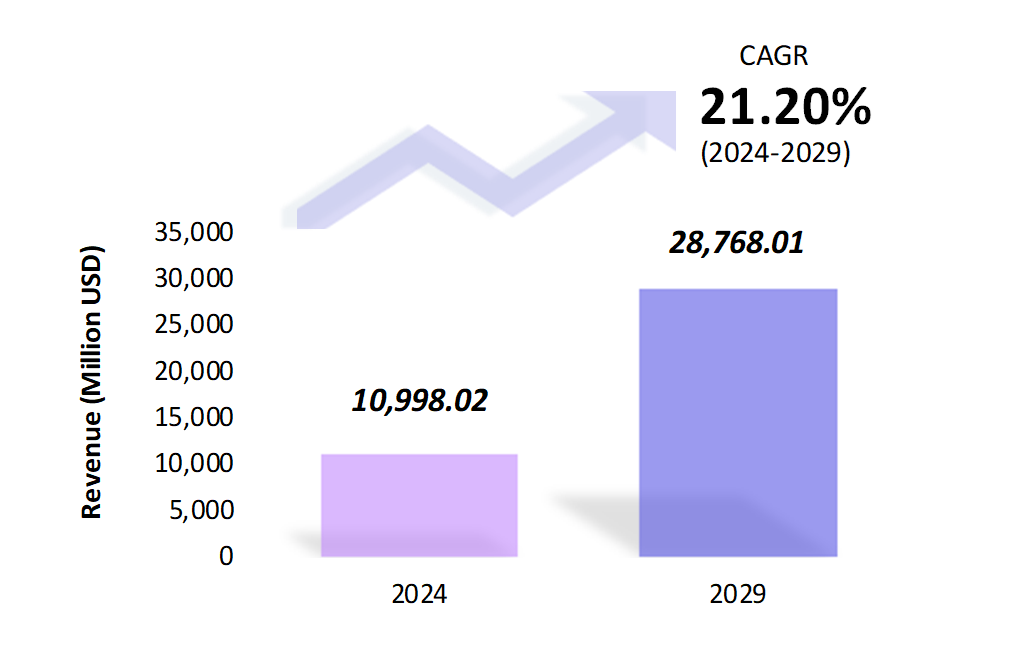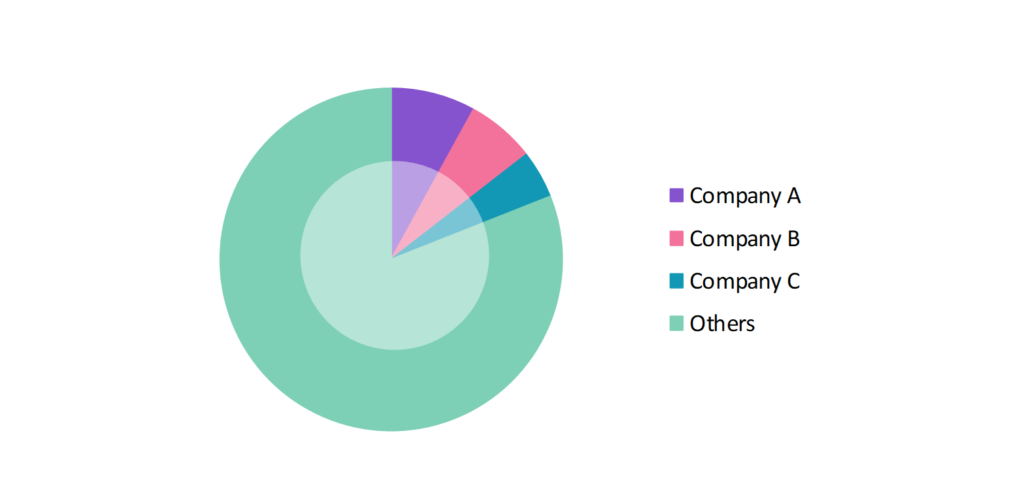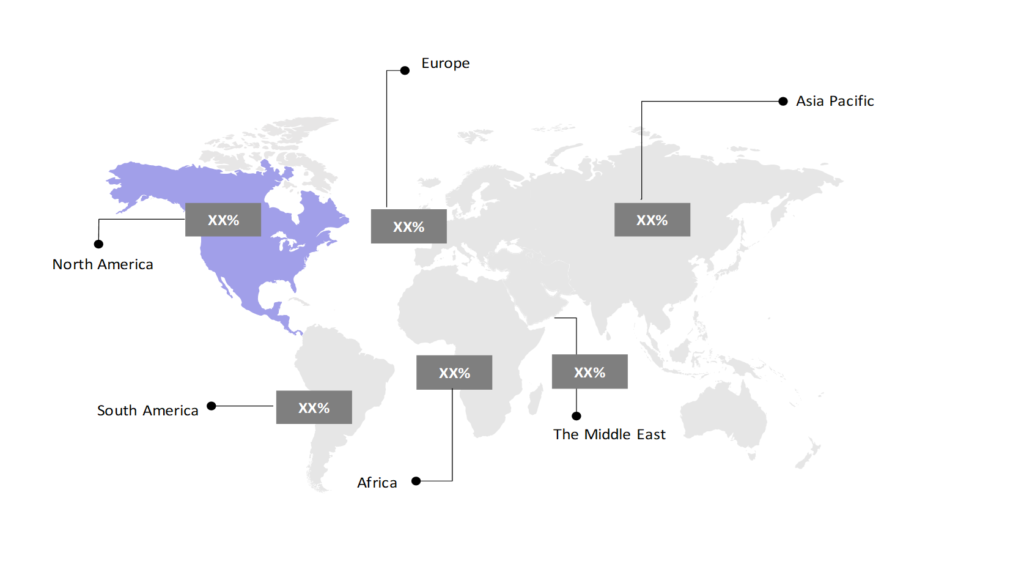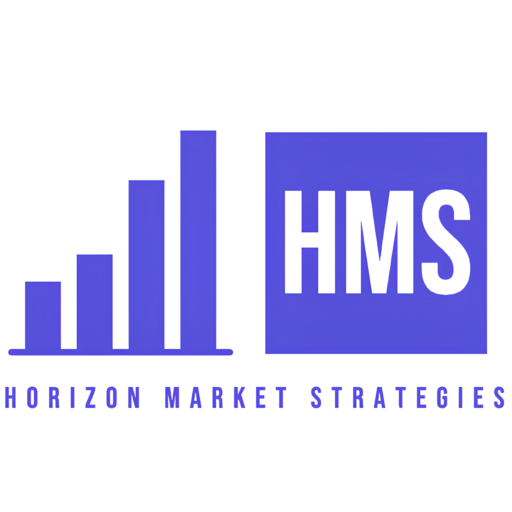Fuel Cell Market Insights: Size, Share, Growth Analysis & Forecast (2024-2029)
The market report offers a detailed analysis segmented by Product (Proton Exchange Membrane Fuel Cell (PEMFC), Solid Oxide Fuel Cell (SOFC), Molten Carbonate Fuel Cell (MCFC), Phosphoric Acid Fuel Cell (PAFC), Others); by Application (Stationary, Vehicle, Portable); by End-User (Transportation, Residential, Commercial & Industrial, Military and Defense, Data Centers, Utilities & Government); by Geography (North America, South America, Asia Pacific, Europe, The Middle East, Africa).
Market Dimensions & Growth Potential

- The fuel cell market is estimated to be at USD 10,998.02 Mn in 2024 and is anticipated to reach USD 28,768.01 Mn in 2029.
- The fuel cell market is registering a CAGR of 21.2% during the forecast period of 2024-2029.
- Fuel cells are increasingly being used in data centers, telecommunication facilities, and residential buildings as a reliable and environmentally friendly power source. Their ability to provide an uninterrupted power supply and generate both electricity and heat simultaneously makes them an attractive solution for various stationary applications.
Request a free sample.
Competitive Landscape & Market Positioning in 2023

- The participants in the global fuel cell industry are always developing their strategies to preserve a competitive advantage.
- These companies primarily use acquisitions, R&D, partnerships, and technological launches.
- Several important entities in the fuel cell market include Bloom Energy Corp.; Plug Power Inc.; Ballard Power Systems Inc.; FuelCell Energy, Inc.; Doosan Fuel Cell Co., Ltd.; and others.
Ask for customization.
Report Objectives & Insights
| Attributes | Values |
| Historical Period | 2018-2022 |
| Base Year | 2023 |
| Forecast Period | 2024-2029 |
| Market Size (2024) | USD 10,998.02 Mn |
| Market Size (2029) | USD 28,768.01 Mn |
| Growth Rate | 21.2% CAGR from 2024 to 2029 |
| Key Segments | Product (Proton Exchange Membrane Fuel Cell (PEMFC), Solid Oxide Fuel Cell (SOFC), Molten Carbonate Fuel Cell (MCFC), Phosphoric Acid Fuel Cell (PAFC), Others); Application (Stationary, Vehicle, Portable); End-User (Transportation, Residential, Commercial & Industrial, Military and Defense, Data Centers, Utilities & Government); Geography (North America, South America, Asia Pacific, Europe, The Middle East, Africa) |
| Key Vendors | Bloom Energy Corp.; Plug Power Inc.; Ballard Power Systems Inc.; FuelCell Energy, Inc.; Doosan Fuel Cell Co., Ltd. |
| Key Countries | The U.S; Canada; Brazil; China; India; Japan; South Korea; The UK; Germany; Italy; France; Australia |
| Largest Market | North America |
Get a free quote.
Market Trends & Future Outlook
- Increasing Adoption in Transportation: The transportation sector is witnessing a significant shift towards fuel cell technology. In December 2023, Toyota announced the expansion of its Mirai FCEV production to meet rising demand in North America and Europe. Similarly, Hyundai’s NEXO has gained popularity in South Korea and international markets, highlighting the growing trend of fuel cell vehicles.
- Expansion of Hydrogen Infrastructure: Developing hydrogen refueling infrastructure is crucial for the widespread adoption of fuel cell technology. In June 2023, the European Union announced a €1 billion investment to build hydrogen refueling stations across member countries, aiming to support the deployment of FCEVs and reduce dependence on fossil fuels.
- Government Support and Incentives: Governments worldwide are implementing supportive policies and incentives to promote fuel cell adoption. In November 2023, the U.S. Department of Energy announced $200 million in funding for fuel cell research and development, focusing on cost reduction and commercialization of fuel cell technologies.
Speak to analyst.
Key Market Influencers & Growth Drivers
- Environmental Concerns: Increasing environmental awareness and stringent emission regulations are driving the adoption of fuel cells. For instance, the European Union’s Green Deal aims to achieve carbon neutrality by 2050, promoting the use of clean energy technologies like fuel cells to reduce greenhouse gas emissions.
- Technological Advancements: Continuous advancements in fuel cell technology are enhancing their performance and reducing costs. In March 2024, researchers at MIT developed a new catalyst that significantly improves the efficiency of hydrogen production, reducing the overall cost of fuel cells and making them more competitive with other energy sources.
- Corporate Sustainability Initiatives: Corporations are increasingly adopting fuel cell technology as part of their sustainability initiatives. In April 2024, Amazon announced plans to deploy fuel cell-powered delivery trucks in its logistics network, aiming to reduce carbon emissions and promote sustainable transportation solutions.
Inquire before buying.
Market Obstacles & Growth Barriers
- Complex Regulatory Environment: The constantly evolving and complex regulatory environment poses a significant challenge for fuel cell adoption. For example, in March 2024, the United States introduced new safety standards for hydrogen storage and transportation, requiring companies to frequently update their compliance strategies and systems.
- Data Security and Privacy Concerns: With the increasing reliance on digital fuel cell solutions, data security and privacy have become major concerns. In April 2024, Maersk, a major European shipping company, experienced a cyberattack that resulted in the theft of sensitive trade data, emphasizing the need for more robust cybersecurity measures.
- Shortage of Skilled Professionals: There is a growing shortage of skilled professionals who can manage and operate advanced fuel cell systems. In May 2024, a survey by the Bureau of Labor Statistics indicated that 55% of businesses struggled to find qualified fuel cell experts, impacting the effective implementation and utilization of these systems.
Personalize this research.
Map Highlighting Key Region in 2023

Explore purchase options.
Table of Contents
| 1. Introduction |
|---|
| 1.1. Research Methodology |
| 1.2. Scope of the Study |
| 2. Market Overview / Executive Summary |
| 2.1. Global Fuel Cell Market (2018 – 2022) |
| 2.2. Global Fuel Cell Market (2023 – 2029) |
| 3. Market Segmentation |
| 3.1. Global Fuel Cell Market by Product |
| 3.1.1. Proton Exchange Membrane Fuel Cell (PEMFC) |
| 3.1.2. Solid Oxide Fuel Cell (SOFC) |
| 3.1.3. Molten Carbonate Fuel Cell (MCFC) |
| 3.1.4. Phosphoric Acid Fuel Cell (PAFC) |
| 3.1.5. Others |
| 3.2. Global Fuel Cell Market by Application |
| 3.2.1. Stationary |
| 3.2.2. Vehicle |
| 3.2.3. Portable |
| 3.3. Global Fuel Cell Market by End-User |
| 3.3.1. Transportation |
| 3.3.2. Residential |
| 3.3.3. Commercial & Industrial |
| 3.3.4. Military and Defense |
| 3.3.5. Data Centers |
| 3.3.6. Utilities & Government |
| 4. Regional Segmentation |
| 4.1. North America |
| 4.1.1. The US |
| 4.1.2. Canada |
| 4.1.3. Mexico |
| 4.2. South America |
| 4.2.1. Brazil |
| 4.2.2. Argentina |
| 4.2.3. Colombia |
| 4.2.4. Chile |
| 4.2.5. Rest of South America |
| 4.3. Asia Pacific |
| 4.3.1. China |
| 4.3.2. India |
| 4.3.3. Japan |
| 4.3.4. South Korea |
| 4.3.5. Rest of Asia Pacific |
| 4.4. Europe |
| 4.4.1. The UK |
| 4.4.2. Germany |
| 4.4.3. Italy |
| 4.4.4. France |
| 4.4.5. Spain |
| 4.4.6. Rest of Europe |
| 4.5. The Middle East |
| 4.5.1. Turkey |
| 4.5.2. UAE |
| 4.5.3. Saudi Arabia |
| 4.5.4. Rest of the Middle East |
| 4.6. Africa |
| 4.6.1. Egypt |
| 4.6.2. South Africa |
| 4.6.3. Rest of Africa |
| 5. Value Chain Analysis of the Global Fuel Cell Market |
| 6. Porter Five Forces Analysis |
| 6.1. Threats of New Entrants |
| 6.2. Threats of Substitutes |
| 6.3. Bargaining Power of Buyers |
| 6.4. Bargaining Power of Suppliers |
| 6.5. Competition in the Industry |
| 7. Trends, Drivers and Challenges Analysis |
| 7.1. Market Trends |
| 7.1.1. Market Trend 1 |
| 7.1.2. Market Trend 2 |
| 7.1.3. Market Trend 3 |
| 7.2. Market Drivers |
| 7.2.1. Market Driver 1 |
| 7.2.2. Market Driver 2 |
| 7.2.3. Market Driver 3 |
| 7.3. Market Challenges |
| 7.3.1. Market Challenge 1 |
| 7.3.2. Market Challenge 2 |
| 7.3.3. Market Challenge 3 |
| 8. Opportunities Analysis |
| 8.1. Market Opportunity 1 |
| 8.2. Market Opportunity 2 |
| 8.3. Market Opportunity 3 |
| 9. Competitive Landscape |
| 9.1. Bloom Energy Corp. |
| 9.2. Plug Power Inc. |
| 9.3. Ballard Power Systems Inc. |
| 9.4. FuelCell Energy, Inc. |
| 9.5. Doosan Fuel Cell Co., Ltd. |
| 9.6. Company 6 |
| 9.7. Company 7 |
| 9.8. Company 8 |
| 9.9. Company 9 |
| 9.10. Company 10 |
Know the research methodology.
Fuel Cell Market – FAQs
What is the current size of the fuel cell market?
In 2024, the fuel cell market size is $10,998.02 Mn.
Who are the major vendors in the fuel cell market?
The major vendors in the fuel cell market are Bloom Energy Corp.; Plug Power Inc.; Ballard Power Systems Inc.; FuelCell Energy, Inc.; Doosan Fuel Cell Co., Ltd.
Which segments are covered under the fuel cell market segments analysis?
The fuel cell market report offers in-depth insights into Product, Application, End-User, and Geography.
